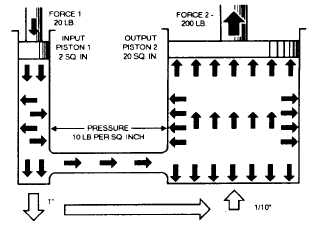PASCAL'S LAW
Pascal was a noted French physicist who discovered that a closed container of fluid could be used to transfer force from one place to another or to multiply forces by its transmission through a fluid. Pascal's law may be stated as follows: PRESSURE APPLIED ANYWHERE ON A CONFINED FLUID IS TRANSMITTED UNDIMINISHED IN EVERY DIRECTION. THE FORCE THUS EXERTED BY THE CONFINED FLUID ACTS AT RIGHT ANGLES TO EVERY PORTION OF THE SURFACE OF THE CONTAINER AND IS EQUAL UPON EQUAL AREAS. It should be noted that Pascal's law applies to fluids-both gas and liquid. It is the use of Pascal's law that makes possible today's hydraulic and pneumatic systems.
According to Pascal's law, any force applied to a confined fluid is transmitted in all directions throughout the fluid regardless of the shape of the container. Consider the effect of this in the systems shown in views A and B of figure 10-1. If there is a resistance on the output piston (view A, piston 2) and the input piston is pushed downward, a pressure is created through the fluid, which acts equally at right angles to surfaces in all parts of the container.
If the force 1 is 100 pounds and the area of input piston 1 is 10 square inches, then the pressure in the fluid is 10 psi ( 100 ÷ 10). It must be emphasized that this fluid pressure cannot be created without resistance to flow, which, in this case, is provided by the 100 pound force acting against the top of the output piston 2. This pressure acts on piston 2 so that for each square inch of its area it is pushed upward with a force of 10 pounds. In this case, a fluid column of uniform cross section is considered so that the area of the output piston 2 is the same as the input piston 1, or 10 square inches; therefore, the upward force on the output piston 2 is 100 pounds-the same as was applied to the input piston 1. All that has been accomplished in this system was to transmit the 100-pound force around a bend; however, this principle underlies practically all mechanical applications of fluid power.
At this point, it should be noted that since Pascal's law is independent of the shape of the container, it is not necessary that the tube connecting the two pistons should be the full area of the pistons. A connection of any size, shape, or length will do so long as an unobstructed passage is provided. Therefore, the system shown in view B of figure 10-1 (a relatively small, bent pipe connects two cylinders) will act exactly the same as that shown in view A.
Multiplication of Forces
In figure 10-1, views A and B, the systems contain pistons of equal area wherein the output force is equal to the input force. Consider the situation in figure 10-2 where the input piston is much smaller than the output piston. Assume that the area of the input piston 1 is 2

Figure 10-1.-Force transmitted from piston to piston.

Figure 10-2.-Multiplication of force.
Continue Reading